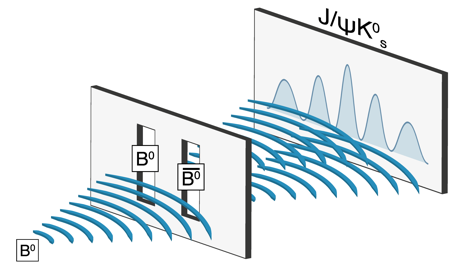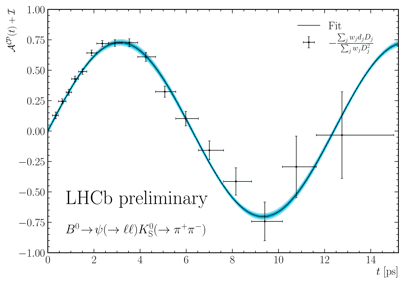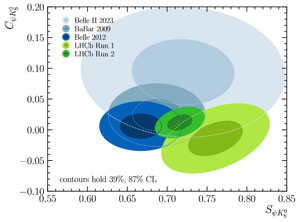Today, at the CERN seminar, the LHCb collaboration presented an important result in our quest to understand the nature and origin of CP violation, which is a difference in behaviour between matter and antimatter. The result, derived from a careful analysis of the full run 2 data sample, is a measurement of the sin2β observable, the key observable in determination of the angle β of the ‘unitarity triangle’. The reported value is more precise than the current world average average and more precise by a factor of about two than the currently most precise experimental result from the BELLE experiment.
This quantity both plays an important role in the recent history of particle physics and continues to be a key measurement in constraining CP violation. The first measurements of the quantity were performed by the e+e– collider B factory experiments BaBar and Belle. These experiments were constructed with the main aim of measuring sin2β. Their results were vital in confirming the broad validity of the Standard Model description of CP violation and led to the award of the 2008 Nobel Prize of Physics to the Japanese theorists M.Kobayashi and T.Maskawa, who had been central in developing this description. It has been long-known that this measurement is a priori more difficult to perform in a hadron collider, such as the LHC, but the large data samples available and optimised design of the LHCb experiment has allowed the world’s best measurement to be made.
The unitarity triangle, see the image above, is a geometrical representation of CP violating and associated parameters in the Standard Model. One side is defined to have unit length, the other two sides and three angles can be measured independently in different decays of beauty hadrons. It is the task of experimental physicists to measure these properties and see if they provide a consistent description of the triangle. Any discrepancy would point to signs of New Physics beyond the Standard Model. The blue band in the plot shows how the measurement of sin2β constrains the apex of the triangle.
The measurement reported today includes three decay modes B0→J/ψ(→μ+μ–)K0s, B0→ψ(2S)(→μ+μ–)K0s and B0→J/ψ(→e+e–)K0s. In all cases the K0s mesons are reconstructed from two charged pion tracks.

The B0 mesons can decay to J/ψKs0 in two ways. They can decay directly to J/ψKs0 or they can oscillate, see 7 November 2012 news, into their antimatter partners B0 which in turn decay also to J/ψKs0. The interference between the amplitudes for the two decay paths results in a time-dependent asymmetry between the decay time distributions of B0 and B0 mesons, as seen in the left image above. The amplitude of the oscillation, called S by the experiments, is a measurement of the sin2β, and gives the magnitude of CP violation present in the process. A value of sin2β=0 would indicate no CP violation. LHCb physicists announced today the value of S/sin2β=0.716±0.013±0.008, which represents the most precise single measurement of the unitarity angle β to date. This Run 2 result has been combined with other LHCb measurements including the previous Run 1 measurement and the value of S/sin2β=0.723±0.014 was obtained.
The right hand side image above shows an artistic view of the B0→J/ψ(→μ+μ–)K0s decay. This possibility of two paths in the decay process is a B physics analogue of the classical quantum mechanics double-slit experiment which inspired the artist.
The image to the left allows to compare measurement of S/sin2β from different experiments (and of an associated variable denoted C). The higher precision of the LHCb’s Run 2 measurement is clearly visible.
Read more in the LHCb presentation, in the CERN update in English and French as well as in the forthcoming paper.



